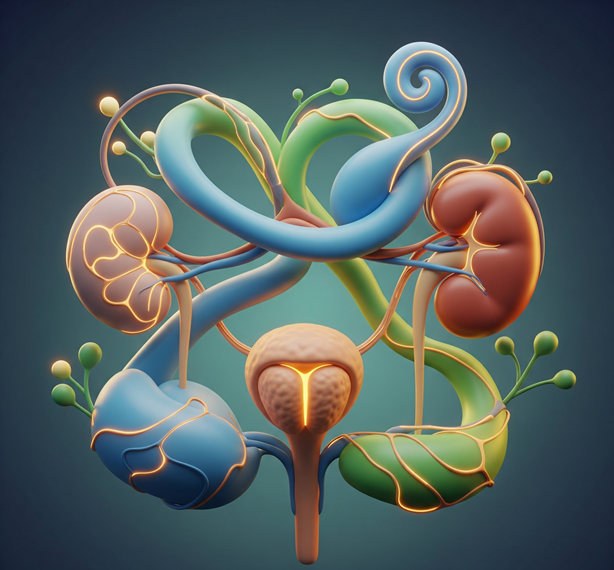Cancer is a word that instantly brings a sense of unease, and when it affects vital organs like those of our urinary system, understanding is key. Urological cancers, encompassing prostate, bladder, and kidney cancers, are among the most common malignancies worldwide, impacting countless lives. While they share the common thread of originating in the urinary or male reproductive systems, each has its unique characteristics, risk factors, symptoms, and treatment approaches.
Let’s shed some light on these “Big C” conditions in the urological realm.
Prostate Cancer: A Men’s Health Concern
Prostate cancer is the most common cancer among men globally, particularly affecting those over 50. In India, it’s also a significant concern, with a substantial number of new cases diagnosed annually.
- What is it? The prostate is a small gland located below the bladder in men, responsible for producing seminal fluid. Prostate cancer occurs when cells in this gland grow out of control. It often grows slowly, but some forms can be aggressive.
- Key Risk Factors:
- Age: The risk significantly increases after age 50.
- Family History: A strong family history of prostate cancer increases your risk.
- Race/Ethnicity: In some populations, like Black men in the US, there’s a higher incidence and often more aggressive forms.
- Obesity and Smoking: While studies have mixed results, these factors may increase risk and aggressiveness.
- Early Warning Signs: Early prostate cancer often has no symptoms. As it progresses, signs may include:
- Difficulty urinating (weak stream, frequent urination, especially at night)
- Painful urination or ejaculation
- Blood in urine or semen (a “do not pass go” moment, seek medical attention immediately)
- Pelvic pain or discomfort
- Bone pain (in advanced stages, indicating spread)
- Screening: The most common screening methods are the Prostate-Specific Antigen (PSA) blood test and a digital rectal exam (DRE). Discussions with your doctor about screening typically begin around age 50, or earlier if you have a higher risk.
- Treatment Advancements: Robotic-assisted prostatectomy offers minimally invasive surgical removal with greater precision and faster recovery. Other options include radiation therapy, hormone therapy, and chemotherapy, often tailored based on the cancer’s aggressiveness and spread.
Bladder Cancer: The Silent Warning in Urine
Bladder cancer is the 9th most commonly diagnosed cancer worldwide. It’s more prevalent in older adults and men.
- What is it? Bladder cancer starts in the cells lining the bladder, the organ that stores urine.
- Key Risk Factors:
- Smoking: This is a major risk factor, responsible for a significant portion of bladder cancer cases.
- Exposure to Chemicals: Certain industrial chemicals (e.g., in the dye, rubber, and leather industries) can increase risk.
- Chronic Bladder Irritation: Chronic infections or inflammation can contribute.
- Early Warning Signs: The most common and crucial symptom is:
- Blood in the urine (hematuria): This can be visible (pink, red, or dark) or microscopic. Even if it’s painless or occurs only once, it warrants immediate medical evaluation.
- Frequent or urgent urination
- Pain during urination
- Pelvic pain
- Screening: There’s no routine screening for bladder cancer in the general population. Early detection relies heavily on recognizing symptoms, particularly blood in urine, and seeking medical attention. Urine tests and cystoscopy (a procedure to look inside the bladder) are common diagnostic tools.
- Treatment Advancements: Intravesical therapy (medication delivered directly into the bladder, like BCG for early-stage), surgery (transurethral resection or cystectomy), chemotherapy, and immunotherapy (which boosts the body’s immune system to fight cancer) are key treatments.
Kidney Cancer: Often Found Incidentally
Kidney cancer, also known as renal cancer, is on the rise, with many cases being discovered incidentally during imaging scans for other conditions. In India, there were over 17,000 new cases in 2022.
- What is it? Kidney cancer originates in the kidneys, the bean-shaped organs that filter waste from the blood and produce urine. Renal cell carcinoma is the most common type.
- Key Risk Factors:
- Smoking: A significant contributor, increasing risk two to three-fold.
- Obesity: Linked to an increased risk.
- High Blood Pressure: Can be a risk factor.
- Family History: Genetic predispositions can play a role.
- Exposure to Certain Substances: Some carcinogens and pain medications.
- Early Warning Signs: Many early-stage kidney cancers are asymptomatic. When symptoms appear, they may include:
- Blood in the urine (hematuria)
- Persistent pain in the back or side, below the ribs
- A lump or mass in the abdomen or side
- Unexplained weight loss and fatigue
- Screening: There are no routine screening tests for kidney cancer for the general public. Incidental findings on imaging scans are common.
- Treatment Advancements: Minimally invasive surgeries like laparoscopic or robotic nephrectomy allow for the removal of the cancerous kidney with smaller incisions and faster recovery. Targeted therapies (medications that specifically attack cancer cells) and immunotherapy are crucial for advanced cases, showing remarkable success. Stereotactic Body Radiotherapy (SBRT) is also an advanced radiation technique.
The Power of Early Detection and Prevention
While each urological cancer has its specific nuances, a common thread unites them: early detection significantly improves outcomes and quality of life. Many of these cancers, when caught in their early stages, are highly treatable, often requiring less aggressive interventions.
What can you do?
- Be Aware of Your Body: Pay attention to any persistent or unusual symptoms, especially changes in urinary habits or the presence of blood in urine. Don’t dismiss them.
- Know Your Risk Factors: Understand if you have a family history or lifestyle factors that increase your risk.
- Talk to Your Urologist: Discuss your concerns and appropriate screening guidelines based on your age, gender, and personal risk profile. Regular check-ups are invaluable.
- Adopt a Healthy Lifestyle: Quitting smoking is paramount for bladder and kidney cancer prevention. Maintaining a healthy weight through a balanced diet rich in fruits and vegetables, and regular exercise, can also lower your overall cancer risk.
The journey through a cancer diagnosis can be challenging, but with continuous advancements in uro-oncology, patients have access to increasingly effective and less invasive treatment options. Knowledge is power, and by understanding these urological cancers, we empower ourselves to take proactive steps towards early detection and better health outcomes.

